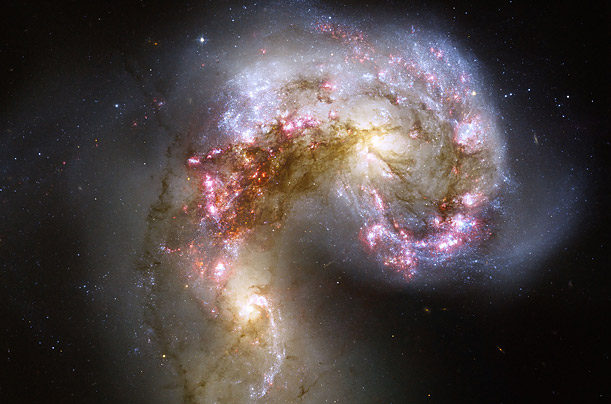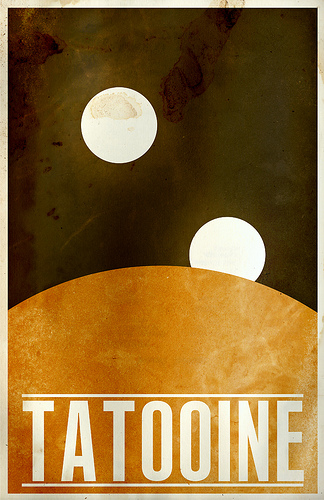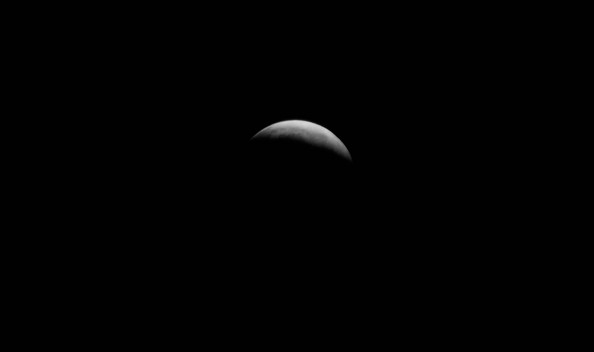
Twenty Years of Hubble.

Haunting the Web Since 1999


(Maybe Black Mesa? That was a joke, ha ha, fat chance.) Y’know, to be honest, I blame the time travelers from the future who should’ve come back and prevented these catastrophic rips in the fabric of space-time. Bang up job, you effing slackers.
“Within 40 small craters, one to nine miles wide, they estimated 600 million metric tons of water. Perhaps most notably, ‘It has to be relatively pure,’ said Paul Spudis, the principal investigator for the instrument that made the discovery.“
By way of a friend, scientists find more evidence of lots of water on the moon. “That is significant, because the ice in these craters could be easily tapped by future lunar explorers — not just for drinking water, but also broken apart into oxygen for breathing and hydrogen for fuel.” Hmm. Maybe it’s time to start thinking of ways to get up there…
“In April, the world will celebrate the quinquagenary of SETI, the search for extraterrestrial intelligence, so it seems a good time to take stock of the silence. Three new books tackle the issue in three different ways. One, an immensely readable investigation of the SETI enterprise (with a surprising conclusion); the second, a technical guide to what we should be looking for and how; and the third, a left-field argument that the alien question has already been answered.“
In New Scientist, Michael Hanlon surveys three new books about the continuing search for alien life, and attempts to grapple with the Fermi paradox.”Today it is rare to meet an astronomer who doesn’t believe that the universe is teeming with life. There is a feeling in the air that light will soon be shed on some of science’s most fundamental questions: is Earth’s biosphere unique? Do other minds ponder the universe?“
“The second law states that a force is proportional to an object’s mass and its acceleration. But since the 1980s, some physicists have eyed the law with suspicion, arguing that subtle changes to it at extremely small accelerations could explain the observed motion of stars in galaxies.” Also on the subject of spinning, a new experiment finds a way to test Modified Newtonian Dynamics (MOND) on Earth, which, if successful, could revise Newton’s heretofore ironclad 2nd law…and explain away the longstanding dark matter problem. (By way of my new favorite Twitter feed, @newscientist.)





Sigh.
Ok, first off, the administration official who uttered the last sentence should be filed away next to Mr. Left of the Left and Ms. Pajamas as people who should no longer speak for the White House in any capacity whatsoever. Full stop, end of story. Putting my speechwriter cap on for a second: In most any political situation, ridiculing the dreams of an entire generation does not make for particularly good messaging.
Anyway, anonymous WH official aside, NASA administrator Charles Bolden sounded a better note about all this: “We’re not abandoning anything. We’re probably on a new course but human space flight is in our DNA. We are not abandoning human space flight by any stretch of the imagination. We have companies telling us they’re excited to get humans off this planet and into orbit. I think we’re going to get there and perhaps quicker than we would have done before.“
And, to be clear, the administration’s NASA budget increases the agency’s funding by $6 billion over the next five years. The new budget ups research and development spending into cheaper heavy launch mechanisms, emphasizes more robotic exploration missions and observational experiments into climate change, extends the life of the ISS (although, with only five more shuttle missions remaining, other nations will have to help service it), and works to promote the various commercial space enterprises moving along right now.
All of this is well and good, but it would be nice to see some recognition of the civic importance of manned space flight by this administration. In their words, NASA is scrapping Constellation on account of it being “over budget, behind schedule, and lacking in innovation due to a failure to invest in critical new technologies.” And, given that we still had a lot of the expenditures before us, I suppose now was as good a time as any to kill the program if it’s not the right direction to go in.
That being said, how many more times are we going to do this? We keep stopping and starting and stopping and starting our post-Shuttle plans for space, so that now, after five final shuttle missions this coming year, we will longer have the capability anymore as a nation to send men and women into orbit. “If implemented, the NASA a few years from now would be fundamentally different from NASA today. The space agency would no longer operate its own spacecraft, but essentially buy tickets for its astronauts.” Forty-one years after we first reached the moon, that’s just plain sad.
Ultimately, the central finding of the Augustine commission’s final report, released this past October after extensive study of NASA’s current situation, is a sound one: “The U.S. human spaceflight program appears to be on an unsustainable trajectory. It is perpetuating the perilous practice of pursuing goals that do not match allocated resources.” In other words, we’ve been trying to talk the talk without walking the walk. If we’re going to get serious about manned space flight, we need to stop piecemealing NASA and start making manned exploration a funding priority.
In total, the agency is slated to get $100 billion over the next five years. To put that number in perspective, that’s less than a fifth of our defense budget for 2011 alone, and that’s going by the most conservative numbers around — NASA’s five-year budget could be closer to a tenth of next year’s defense spending. (For its part, the Augustine commission set a price tag of $3 billion a year to get serious about manned exploration.)
If we had put anywhere near that kind of money into exploration and R&D over the years, would we now be in this position, where we face the Hobson’s choice of replicating expensive 50-year-old launch tech or being completely grounded as a nation? The lack of thinking about our long-term priorities sometimes is staggering to me. I’ve said this before, but I still believe it holds true: Short of possibly genomic research and advances in AI, nothing we do right now will matter more centuries or millennia hence than establishing a presence off-world…if we even have that long. Not to get all Jor-El up in here, but we really have to start getting serious about this.
“Although that panel suggested a $3 billion boost to NASA’s $18.7-billion-a-year budget in order to take a firm next step in human space flight, Obama’s support for a $1 billion bump next year represents a major coup for the agency given the ballooning deficit and the continuing recession. And NASA just won a $1 billion boost from Congress for 2010 in a bill signed by the president.” By way of another friend, President Obama backs increased funding for NASA’s new heavy launcher. “The president’s decision to go with the second option is a major departure from his 2010 budget plan, which called for a 5% increase in 2010–the boost just approved by Congress–but then remaining flat through 2014.“
Good, although I do wish he’d gone the full $3 billion. In the great scheme of things, not much we do is of larger importance than manned space flight. And 10,000 years from now, people aren’t going to remember or much care how many Joint Strike Fighters we built in the Twenty-Tens. But they will know whether or not we took significant steps to leave the cradle and move off-world.
“‘There’s going to be all kinds of weird stuff out there,’ said Alan Boss of the Carnegie Institute of Washington, who wasn’t part of the research. ‘This is an unparalleled data set. The universe really is a weird place. It’s fantastic.’” In the midst of its current planet–hunting sweep, NASA’s Kepler telescope discovers two examples of a new type of heavenly body that are “too hot to be planets and too small to be stars.” (Although some think they’re recently-born planets; others dying “white-dwarf” stars.) “‘The universe keeps making strange things stranger than we can think of in our imagination,’ said Jon Morse, head of astrophysics for NASA.”
“Any intact lava tube could serve as a shelter from the severe environment of the lunar surface, with its meteorite impacts, high-energy UV radiation and energetic particles, and extreme diurnal temperature variations.” In a tube in the ground lived…a human? An international team of researchers identify a lava tube in the moon’s Marius Hills as a good spot for a lunar colony. Just watch out for the exogorths.